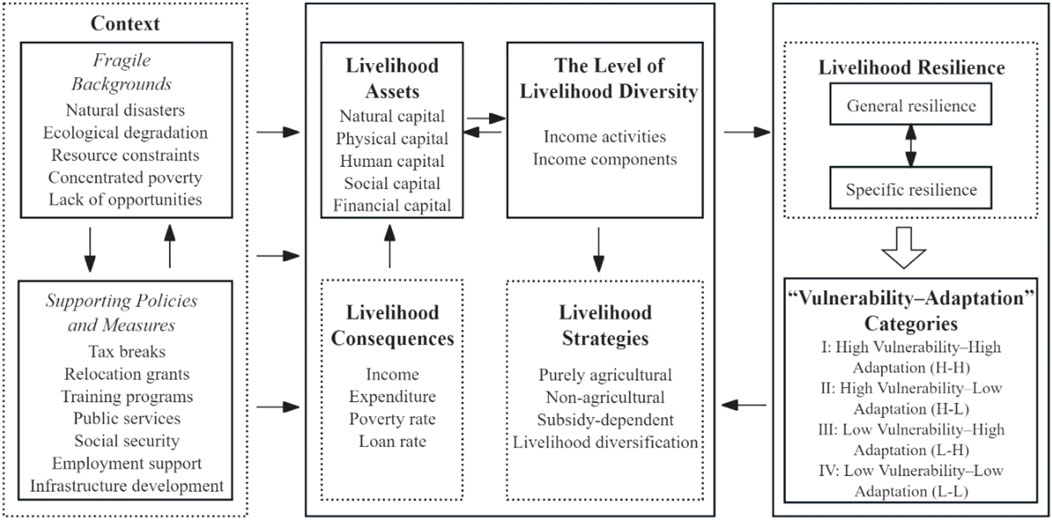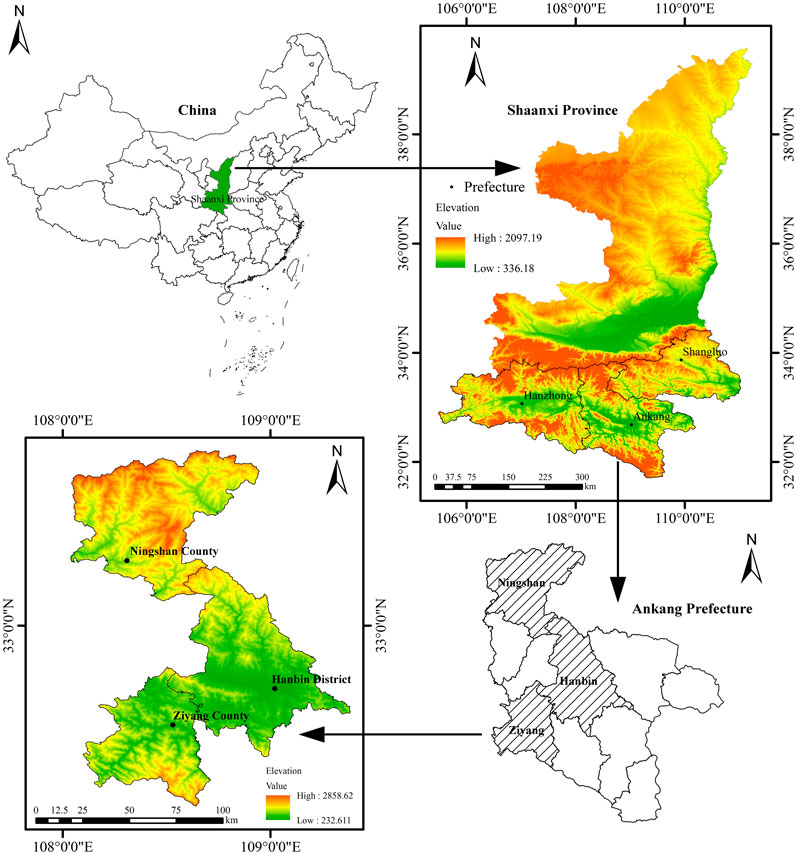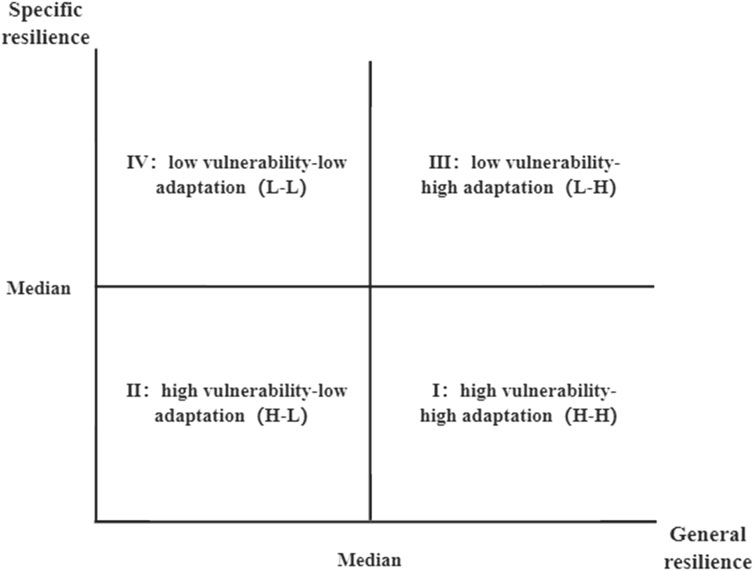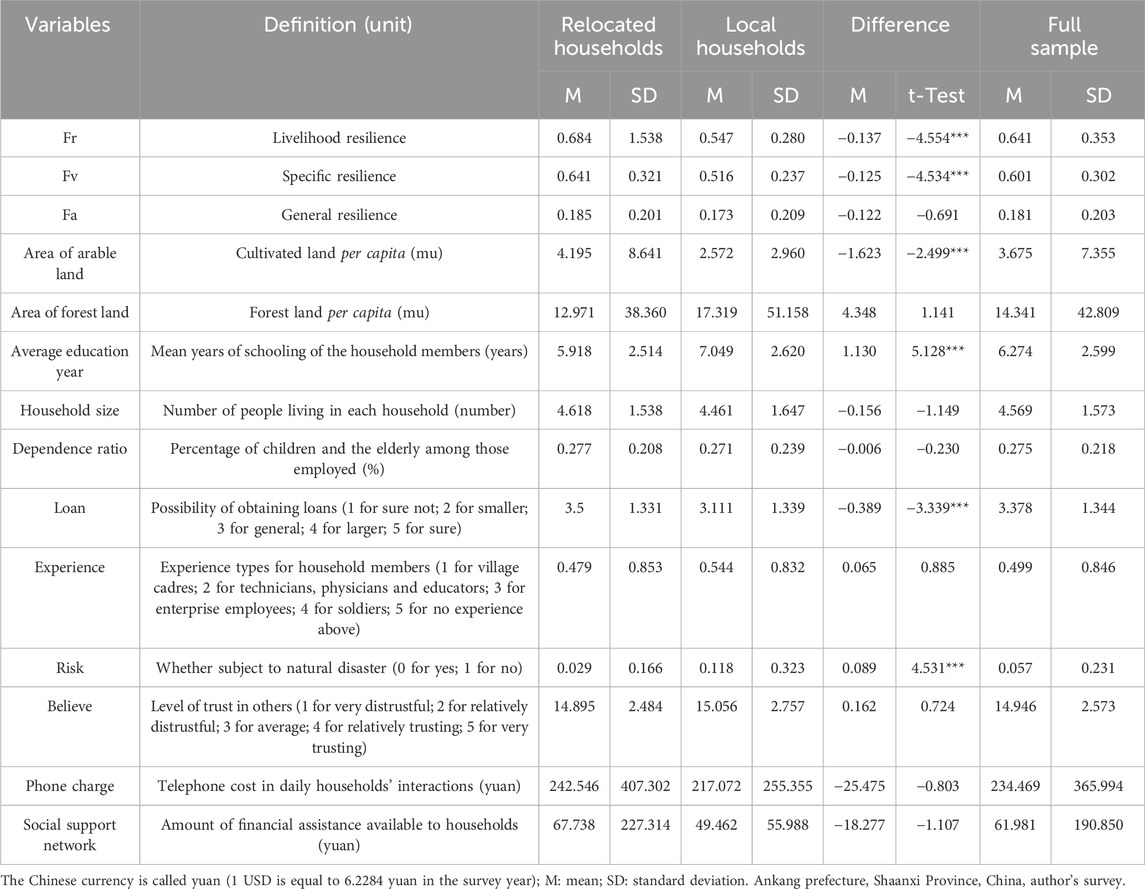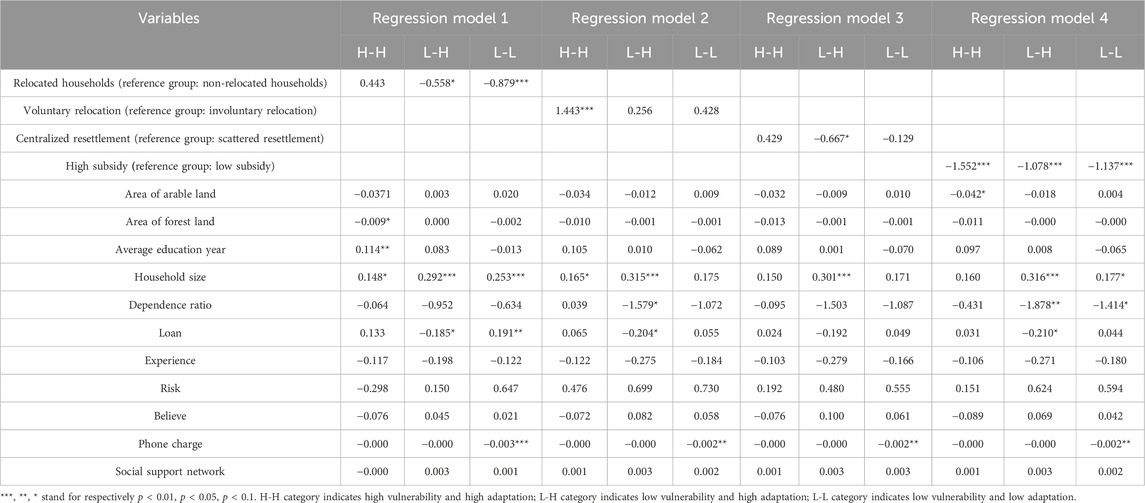- 1School of Public Administration, Xi’an University of Architecture and Technology, Xi’an, China
- 2Department of Biology, Stanford University, Stanford, CA, United States
In the face of environmental deterioration and to improve human welfare, China’s Shaanxi provincial government has launched one of the largest disaster shelter and resettlement projects in history. In assessing the likely success of this project, it is important to measure the vulnerability and adaptation of rural households in areas where the population experiences ecological and livelihood vulnerability. Based on 657 rural questionnaires collected in southern Shaanxi relocation zones, this study explores four categories of relationship between vulnerability and adaptation based on two aspects of livelihood resilience, namely specific resilience and general resilience. A multinomial logistic regression model is employed to investigate the influence of disaster resettlement on these categories. The analysis finds that: (1) there is a connection between these categories and household livelihood strategies, and rural households are more likely to adopt non-agricultural strategy or livelihood diversification strategy; (2) the livelihood resilience of relocated households is significantly higher than that of non-relocated household, with specific resilience being the main reason for the difference; (3) participation in disaster resettlement, centralized resettlement, and high relocation subsidies are not conducive to belonging in the “low vulnerability–high adaptation” category, while voluntary relocation is conducive to being in this category. These results have significant ramifications for China and other developing national disaster resettlement programs. It is critical for resettled households to reduce livelihood vulnerability and improve adaptive capacity.
1 Introduction
With the scale and frequency of natural disasters increasing globally, security and social development of citizens residing in impoverished areas of developing nations are facing significant challenges (United Nations Environment Programme, 2023). To mitigate natural disasters caused by environmental problems, improve ecosystems, and enhance people’s wellbeing, resettlement has become an option (Yang et al., 2020). Previous studies have focused on development-induced displacement and resettlement (DIDR) (Xu H. et al., 2022), but theoretical and empirical studies on disaster-induced resettlement are rather rare (Guo and Kapucu, 2017). Disaster resettlement is an option available for residents who can no longer remain in their original communities because of natural disasters (Xu J. et al., 2022). The complexity of potential settlers’ needs results in resettlement having multiple implications that may increase the likelihood of social risk and conflict (Shi et al., 2020). Around the world, many disaster-related resettlement projects have been implemented, such as the resettlement project after Hurricane Mitch in Honduras in 1998 (Jonas, 2019), the resettlement project after the floods in Pakistan in 2010 (Jamshed et al., 2019), and the disaster avoidance and migration relocation project in the southern part of Shaanxi Province in China in 2011 (Li et al., 2018). However, more investigation is needed regarding the context, impact, and scope of rebuilding livelihoods (Guo and Kapucu, 2018). Livelihood is a people-centered concept, representing not only a means of survival but also opportunities for improving lives (Sina et al., 2019a). Numerous studies have shown that disaster resettlement and livelihoods are somewhat dissociated at the rural household level. Moreover, Christoplos et al. (2001) have suggested that there is a significant tendency for rural household livelihoods to be neglected after resettlement. Maintaining the sustainability of households’ livelihoods is an urgent issue and is relevant to the economic and social success of disaster resettlement (Guo and Kapucu, 2018).
The concept of resilience has been debated, and it is interpreted in various ways. Current research on social-ecological system resilience is increasingly focused on livelihoods, namely livelihood resilience (Sun et al., 2023). Livelihood resilience has been proposed as part of the sustainable livelihood framework (Chambers and Conway, 1992) and refers to the capacity of individuals, social organizations, or social-ecological systems to respond to perturbations, as well as to deal with change and rebound from negative impacts (Speranza et al., 2014). Many scholars have attempted to explore livelihood resilience in different research contexts, such as natural disasters (Sina et al., 2019b; Yan et al., 2022), climate change (Fan et al., 2022; Li and Shi, 2023), and policy changes (Wang et al., 2024). Researchers have also analyzed the determinants of livelihood resilience in specific populations or regions, such as the Tibetan Plateau (Li et al., 2022), the Gannan Plateau (Zhao et al., 2021), rural residents in disaster areas (Zhou et al., 2021; Lu et al., 2022) and reservoir migrant households (Gong et al., 2020; Chen et al., 2023). The current literature deals mainly with how to establish livelihood resilience, a framework for analyzing livelihood resilience, and adaptive management responses to enhance livelihood resilience (Zhao et al., 2021; Wang and Zhao, 2023). The measurement of livelihood resilience is challenging, and consistent measurement methodologies and research paradigms have not yet been developed. For example, Tang et al. (2023) drew on the “Exposure-Sensitivity-Adaptation” framework to measure livelihood resilience. Wang and Zhao (2023) constructed a livelihood resilience assessment indicator based on three components, namely, absorptive capacity, adaptive capacity, and transformational capacity. Liu et al. (2020a) used three components of livelihood resilience—buffer capacity, self-organizing capacity, and learning capacity—to investigate livelihood resilience. Most previous studies used indicator measures, but livelihood resilience is dynamic, non-linear, and complex, and few studies have attempted to approach the livelihood resilience of households using the space-vector method from systems engineering (Liu and Li, 2017a; Li et al., 2020). The quantitative criteria and research paradigms for investigating livelihood resilience are still under debate. However, studying the development of rural areas and the sustainability of households’ livelihoods from the perspective of endowments and capacities possessed by the households, rather than from the perspective of livelihood capital may become a new approach.
Households’ capacities are formed during the interaction of their livelihood systems with externally induced disturbances. These capacities enable households to optimize their strategies with limited resource endowments when facing future environmental changes, so as to make their livelihood level better than or equal to its previous state, thus achieving sustainable development under the new environmental conditions (Speranza et al., 2014; Li et al., 2021). To describe the capacities that households possess, this paper follows previous literature in introducing livelihood resilience to describe households’ livelihood systems. Livelihood resilience, as a specific expression of resilience in livelihoods, represents a new approach to observing the sustainability of livelihoods of rural households in disaster resettlement areas (Folke et al., 2010). It is well known that resilience is the capacity of a system to keep its fundamental structure, function, and properties even after it has been subjected to shocks and perturbations (Tambo, 2016). The intensity of external disturbances and the threshold at which resilience is manifested have important implications for system dynamics. For households’ livelihood systems, an increase in livelihood resilience is not only conducive to the rapid recovery of their livelihoods, but also contributes to a fundamental increase in their ability to cope with risk (Li and Gao, 2019a). According to whether there is a specific type of impact or general unpredictability, resilience can be divided into specific resilience and general resilience (Folke et al., 2010). Resilience of specific parts of the system to cope with certain shocks through changes in the relevant control variables is called specific resilience, while general resilience is the system’s overall capacity to withstand a variety of unpredictable risks. The present study attempts to understand resilience from an income perspective, viewing it as the result of the interaction between rural household incomes and livelihood composition in the face of change, which correspond to the vulnerability and adaptive dimensions, respectively (Liu and Li, 2017b). Thus, by observing the extent of livelihood diversity of rural households, we can measure and characterize specific and general resilience, identify four categories of “vulnerability–adaptation”, compare the characteristics and resilience levels of rural households in different categories, and explore the impacts of disaster resettlement on the livelihoods of rural households in these different categories.
As mentioned above, relocation projects aim to alleviate the impacts of natural disasters resulting from environmental issues and enhancing livelihoods has become an important tool for poverty alleviation in developing countries (Rogers et al., 2019). However, disaster resettlement may lead to new dilemmas for livelihood development, so it is important to reduce rural households’ reliance on their livelihoods and increase their adaptation to environmental and social perturbations (Liu et al., 2020a). Despite the large amount of research carried out on livelihood vulnerability and adaptation, there has been little examination of the two dimensions of resilience, and little delineation of the above categories in the context of their spatial associations. This study analyzes the implications of disaster resettlement on “vulnerability–adaptation” categories in southern Shaanxi by measuring specific and general resilience. This is of theoretical significance to the study of vulnerability and adaptation of livelihoods at the household level. First, we draw on the sustainable livelihoods framework to propose the “vulnerability–adaptation” categorization of households; second, we suggest four categories of “vulnerability–adaptation” according to specific resilience and general resilience of households; and last, based on a comparative analysis of the characteristics of these categories and the resilience of households’ livelihoods, we use multi-category logistic regression to investigate the effects of disaster displacement and different relocation characteristics on the “vulnerability–adaptation” dimension of rural households. We aim to address the following two questions. (1) What are the levels of livelihood resilience and its different dimensions for rural households in disaster resettlement areas in southern Shaanxi, China? (2) How does the kind of disaster relocation affect the “vulnerability–adaptation” categories of rural households? By addressing these issues, we can contribute to policy formulation regarding the resilience of the livelihoods of rural households in disaster resettlement zones. The second part of the paper proposes a theoretical analytical framework, the third part is data and methods, the fourth part is the empirical analysis, the fifth part is the discussion, and the sixth is the conclusions.
2 Conceptual framework
Figure 1 shows an analytical framework for exploring the impact of disaster resettlement on the “vulnerability–adaptation” categories of rural households. Adapted from Li et al. (2020) and Liu et al. (2020a), it was originally known as the “Sustainable Livelihoods Framework” (Department for International Development, 1999). The framework shows the linkages between alterations in livelihood capital, livelihood resilience, and shifts in livelihood strategies. These interact in a complex manner, revealing not only the underlying causes of poverty, but also the constituents of sustainable livelihoods, providing a compelling approach for examining how relocation factors affect “vulnerability–adaptation” categories.
We consider the vulnerability context and government support measures. The vulnerability of rural households in disaster resettlement areas has two components, livelihood vulnerability and ecological vulnerability (Liu et al., 2020a; Li et al., 2020). Government support measures are implemented via a series of policies, such as migrant relocation subsidies, infrastructure construction, tax exemptions, training programs, public services, social security, and employment support. Developments in the outside environment affect the building of rural households’ assets, livelihood resilience and choice of livelihood strategies, which play a fundamental part in our analytical framework.
Livelihood capital refers to the resources possessed by rural households. It is used to describe the ability of rural households to react to challenges when facing external shocks, and consists mainly of natural capital, physical capital, human capital, social capital, and financial capital (Samane et al., 2023). Livelihood diversity refers to the capacity of rural households to have multiple means of sustaining their livelihoods, including activities that produce income (Liu and Li, 2017a). Livelihood capital can increase rural households’ options by promoting the diversity of livelihoods. In turn, livelihood diversity can contribute to the accumulation and growth of livelihood capital, enabling rural households to more effectively adapt to changes in their external environment. The two are interconnected and serve as the foundation for rural households’ ability to maintain their livelihoods, while also affecting their resilience (Liu and Li, 2017b). The degree of livelihood diversification and the adequacy of livelihood capital have a direct impact on rural households’ resilience. According to Liu and Li (2017a), the two dimensions of livelihood resilience, namely specific resilience and general resilience, can correspond to the vulnerability and adaptability of rural households, respectively. We divide the relationship between the vulnerability and adaptation of rural households into four categories: high vulnerability–high adaptation, high vulnerability–low adaptation, low vulnerability–high adaptation, and low vulnerability–low adaptation. This classification of livelihood strategies provides an entry to the formulation of sustainable development policies.
Livelihood strategies are activities that aim to achieve livelihood objectives based on available assets, and include purely agricultural activity, non-agricultural activity, subsidy-dependence, and livelihood diversification type. Households adopting diversified and non-agricultural livelihood strategies not only broaden their income streams and reduce their livelihood vulnerability, but also have increased adaptive capacity and reduced dependence on natural resources compared to households that adopt purely agricultural and subsidy-dependent livelihood strategies (Liu et al., 2020a). Differences in the income received by households as well as policies, institutions, and the environment directly affect the selection of livelihood strategies and their sustainability (Shah et al., 2017).
Figure 1 depicts the framework of the “vulnerability–adaptation” categorization of rural households in the disaster resettlement context. It demonstrates how rural households can reconfigure their livelihood capital to improve livelihood resilience, construct new livelihood strategies, and thus optimize their livelihood strategy when faced with changes in outside conditions caused by disaster resettlement. In the following section, the framework is employed to demonstrate how disaster resettlement particularly affects the “vulnerability–adaptation” categories.
3 Materials and methods
3.1 Data sources
The data comes from a survey on the livelihoods of rural households in the Ankang area of southern Shaanxi province (Figure 2). Ankang prefecture is situated in a special hardship area in the Qinba Mountains, where the vulnerability of rural households to poverty is high, and the residents are in remote areas in the high mountains and areas prone to natural disasters. Ankang is an essential water source protection area for China’s South-to-North Water Diversion Project. It contains a number of prohibited and restricted development areas with key ecological functions and faces many difficulties and challenges in economic and social development (Liu et al., 2018). To address these issues, the local government launched the Ecological Migration Project in 2011, involving 226,000 households and 880,000 rural people in Ankang (Liu et al., 2020b). After the implementation of the project, poverty alleviation was significant, and living conditions of households were greatly improved. Thus, Ankang represents a typical example of how to decrease vulnerability, boost adaptation and improve human wellbeing.
The sample area for the field survey included three representative centralized resettlement neighborhoods in Ziyang County and eight administrative villages in four townships in Ningshan County and Hanbin District. The survey took the form of a structured questionnaire and semi-structured interviews and involved a random sample of residents who were at home on that day during the survey period. The survey was conducted with heads of households or spouses of heads of households or other permanent residents aged 18–65 years old. It included information on household demographics, livelihood capital, household livelihood activities, sources of income, and circumstances related to the households’ migration and relocation. The group undertook a series of quality control measures on the collected data. Through the questionnaire design, questionnaire recovery, data cleaning, data correction, data remediation and other work processes, a total of 657 valid questionnaires were recovered, a rate of 98.06%. Among them, 459 were for relocated households and 198 for non-relocated households.
3.2 “Vulnerability–adaptation” categories
Regarding the construction of livelihood resilience, we refer to Li et al. (2021) and Liu et al. (2024). Livelihood resilience can be expressed as the capacity of a rural household to withstand disruption and keep its basic structure and functions by engaging in a variety of livelihood activities. It includes both specific resilience and general resilience. Specific resilience refers to diversity levels, and its diversity index assesses vulnerability attributes. The greater the specific resilience of the rural household, the greater the number of income streams available and the lower the vulnerability of the household. General resilience refers to changes in income from livelihood diversification, while income level measures adaptation attributes. The greater the general resilience of the rural household, the more stable the level of income and the greater the adaptability of the rural household.
Following previous studies (Wang et al., 2017), we use a four-quadrant classification to categorize vulnerability–adaptation axes of specific resilience and general resilience, respectively. There are four “vulnerability–adaptation” categories (Figure 3): Category I: high vulnerability–high adaptation (H-H); Category II: high vulnerability–low adaptation (H-L); Category III: low vulnerability–high adaptation (L-H); Category IV: low vulnerability–low adaptation (L-L). Among these, the L-H is optimal, the H-H and L-L are sub-optimal, and the H-L is the worst.
3.3 Selection of influencing factors
Using the “vulnerability–adaptation” category as the dependent variable, relocation factors were chosen as independent variables, and variables covering both household and community levels were selected as control variables (Li et al., 2020). Multiple regression was used to find the key elements associated with the categories. The settings of the variables and descriptive statistics are in Table 1.
Relocation factors included relocation nature, relocation type, and relocation subsidy. Of these, relocation nature included voluntary and involuntary relocation; 86.56% of the relocated households underwent voluntary relocation. Relocation type was divided into centralized resettlement and scattered resettlement; 76.42% of the relocated households underwent centralized resettlement. Relocation subsidy was classified as high or low; 62.97% of the relocated households received a high relocation subsidy.
Variables at both the household and community levels included area of arable land, area of forest land, average years of education, household size, dependence ratio, loans, experience, risk, belief, phone charges, and social support network (Liu et al., 2020b). More arable land area and forest land area owned indicates that the rural household can obtain more provisioning services from the ecosystem. Average years of education, household size, and dependence ratio are important factors affecting the income of rural households from livelihood activities and reflect to some extent the level of human capital of rural households. Larger household size indicates that the number of laborers in a rural household is likely to be higher, and the income generated is likely to be greater as a result. Higher household dependence ratios indicate a lower buffering capacity, making it difficult to accumulate savings for emergencies. The greater the credit capital, the larger the capacity of the household to withstand risk. The wealth of experience of rural households and the degree of exposure to natural disasters are important factors affecting their resilience to risk. Households with higher levels of belief in others, higher phone charges, and larger social support networks are more likely to receive external assistance in coping with emergencies and are thus better able to sustain their livelihoods.
3.4 Econometric model
A multinomial logistic model was employed to estimate the effects of relocation on the “vulnerability–adaptation” categories of rural households. The analysis consisted of two parts: first, we used the whole sample to investigate how relocation decision-making affected the category. We then used a sample of relocated households to investigate how various relocation factors affected the category. The calculation is as follows (Equation 1),
where Prob (
4 Results
4.1 Comparison of livelihood strategies of rural households
Table 2 compares the livelihood strategies used by rural households that are in the various categories. Overall, the proportion of households adopting non-agricultural strategy was the largest, followed by livelihood diversification strategy and purely agricultural strategy, and the proportion of households relying entirely on government subsidies was the smallest at less than 10%.
The L-L category had the largest proportion of all pure agricultural households and livelihood diversification households; the H-H category had the largest proportion of all non-agricultural households; the H-L and L-L categories had the largest proportion of all subsidy-dependent households. H-L and L-H categories shared some similarities, with both having the largest share of non-agricultural households; however, for H-L, the share of purely agricultural households was the smallest, and for L-H, the share of subsidy-dependent households was the smallest.
These findings demonstrate that rural households’ dependency on traditional livelihoods as a livelihood strategy improved, with more non-agricultural or livelihood diversification households. In addition, there was a correlation between the different categories and livelihood strategies, with H-L households being less likely to be purely agricultural, whereas L-H were less likely to rely on government subsidies.
4.2 Comparison of types of rural households
Table 3 compares the numbers and percentages of different kinds of rural households according to relocation factors. Within the categories of relocated households, voluntary relocation, and centralized resettlement, the share of H-H households was the largest, while the share of L-H families was the smallest. This suggests that those strategies have a higher likelihood of becoming H-H. In comparison, a larger proportion of L-H households and the smallest proportion of H-H households were found to be non-relocated, involuntarily relocated, and scattered households. Furthermore, the share of H-L households was the largest and the share of both L-L and L-H households was the smallest among households with high relocation subsidies, indicating that high relocation subsidies are more likely to lead households to become H-L.
4.3 Comparison of rural households’ livelihood resilience
Table 4 compares the livelihood resilience and dimensions of resilience according to various relocation factors. Relocated households exhibited noticeably higher livelihood resilience than non-relocated households. This difference can be attributed to specific resilience, which was significantly higher in relocated than non-relocated households, whereas the two groups did not show a significant difference in general resilience. For voluntarily relocated households, livelihood resilience was significantly higher than that of involuntarily relocated households, and while it was also higher in terms of both specific resilience and general resilience, the difference was not significant. For centralized settled households, specific resilience was significantly higher than that of scattered settled households, while the general resilience was lower but not significantly; the difference in livelihood resilience between them was not significant. For high relocation subsidy households, livelihood resilience was lower than that of low relocation subsidy households, but not significantly, mainly because they did not show significant differences in specific resilience. For general resilience, high relocation subsidy households were significantly lower than low relocation subsidy households.
For relocated, non-relocated, and all-farm households, the kernel density of livelihood resilience is shown in Figure 4. Figure 4A shows that the specific resilience of non-relocated households fluctuated little and peaked around resilience 0.4; in comparison, the kernel density curves of relocated households and all-farm households were flatter and had a distinctive multi-peak pattern, with sharp fluctuations in resilience. Figure 4B shows that the general resilience distributions of relocated households, non-relocated households, and all households exhibited small differences with very steep curves, indicating that the livelihood resilience fluctuations of all three groups were small and concentrated at a low mean value.
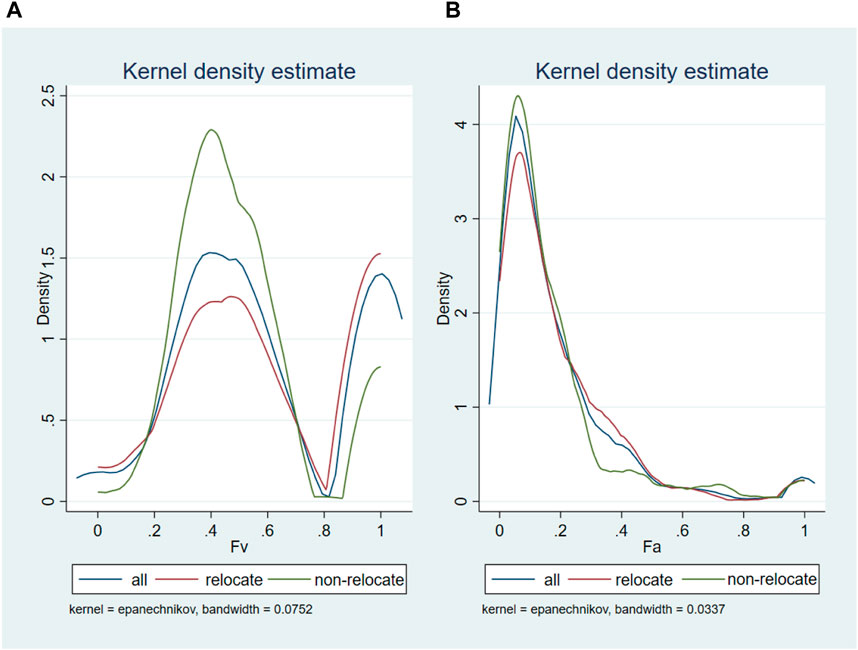
Figure 4. Estimated kernel density of household livelihood resilience (A). Specific resilience; (B). General resilience based on whether relocated: all (100%); relocate (69.86%); non-relocated (30.14%).
For voluntarily relocated households, involuntarily relocated households, and all relocated households, the distribution of livelihood resilience is shown in Figure 5. Figure 5A shows that the kernel densities for specific resilience of voluntarily relocated households and all relocated households were less different, with similar and steeper curves and a clear multi-peak pattern, indicating that there was less fluctuation in resilience and bifurcation in these two groups. Involuntarily relocated households peaked near the specific resilience of 0.4, and the density curves were also steeper, with less fluctuation in resilience within this group. Figure 5B shows that all three groups had steeper density curves with smaller fluctuations in general resilience, peaking near a resilience level of 0.1.
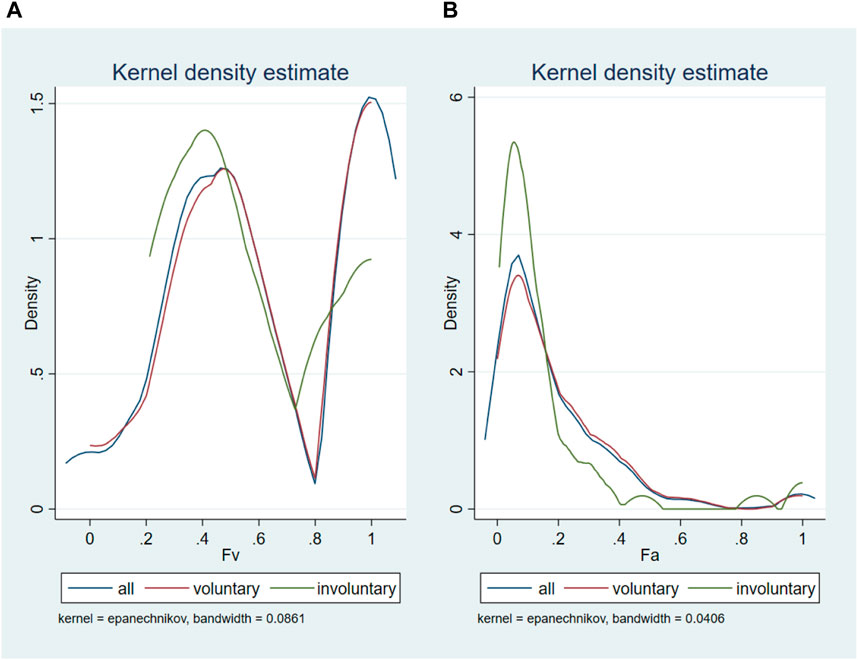
Figure 5. Estimated kernel density of household livelihood resilience (A). Specific resilience; (B). General resilience based on relocation nature: all (100%); voluntary (86.56%); involuntary (13.44%).
For centralized resettlement households, scattered resettlement households, and all relocated households, the kernel density of livelihood resilience is shown in Figure 6. Figure 6A shows that scattered resettlement households had greater specific resilience values than centralized resettlement households. Figure 6B shows that there was no apparent difference in general resilience between centralized resettlement households, scattered resettlement households, and all relocated households, with the kernel density curves all peaking around resilience 0.1.
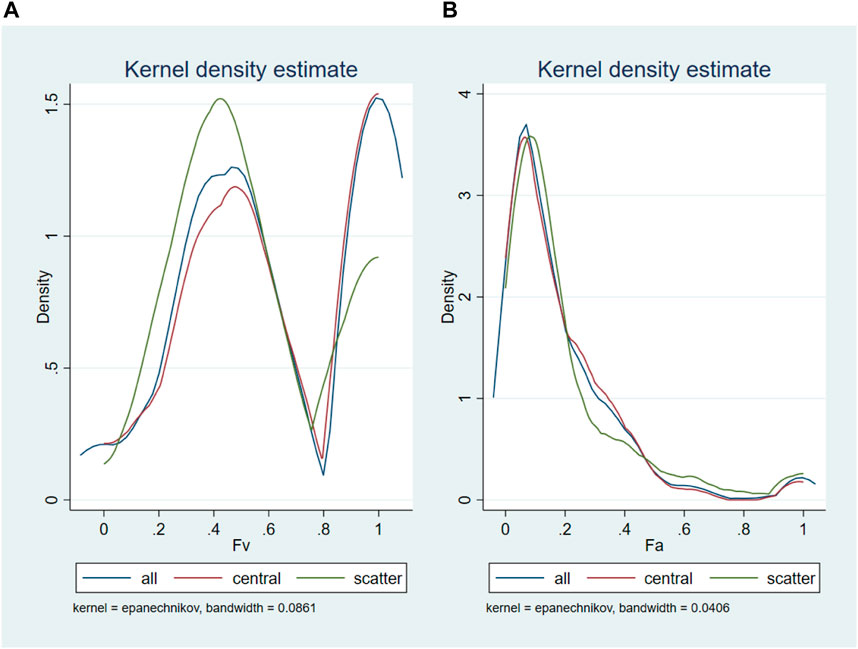
Figure 6. Estimated kernel density of household livelihood resilience (A). Specific resilience; (B). General resilience based on relocation type: all (100%); central (76.42%); scatter (23.58%).
For high relocation subsidy households, low relocation subsidy households, and all relocation households, the density of livelihood resilience is shown in Figure 7. In Figure 7A, for specific resilience, there was a clear multi-peak pattern with polarization. The kernel density curves were shifted to the right with increasing levels of resilience, and the curves for all three groups were very steep, suggesting that the fluctuations in resilience were all small and concentrated at the mean value. Figure 7B shows that general resilience peaked around 0.1 for all three groups; the kernel density curve for low relocation subsidy households was relatively flat, with sharp fluctuations in resilience within the group, while the kernel density curve for high relocation subsidy households was the steepest, with a more centralized distribution of all relocation subsidy households, all of which showed smaller fluctuations in resilience.
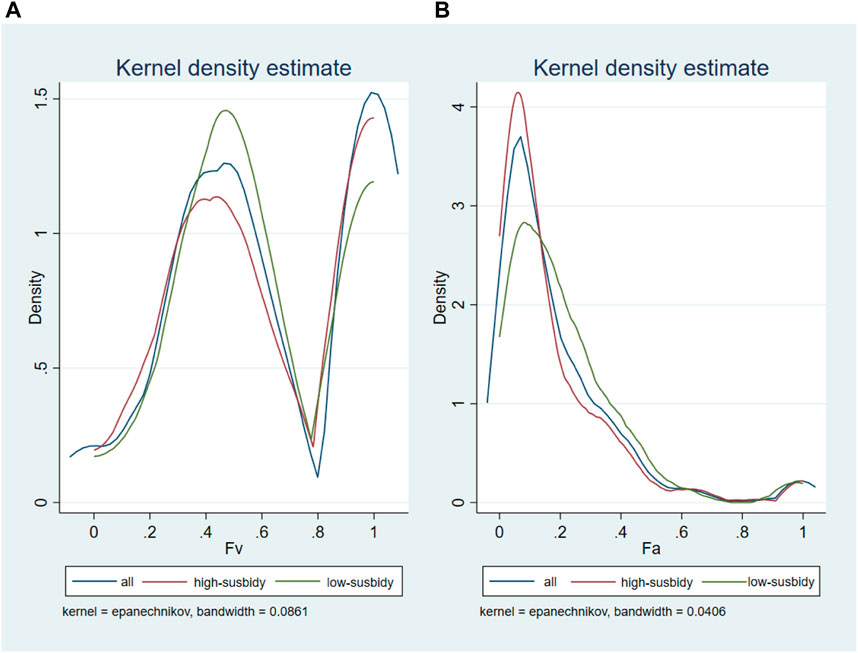
Figure 7. Estimated kernel density of household livelihood resilience (A). Specific resilience; (B). General resilience based on relocation subsidy: all (100%); high subsidy (62.97%); low subsidy (37.03%).
4.4 Effects of relocation factors on “vulnerability–adaptation” categories
Table 5 shows the probabilities of the four “vulnerability–adaptation” categories as the dependent variable as a function of the factors influencing them in the regression analyses. Compared with H-L, model 1 shows that being L-H and L-L is significantly and negatively affected by relocation. Model 2 indicates that, in contrast to H-L, voluntary relocation significantly improves the realization of H-H. Model 3 demonstrates that centralized resettlement significantly reduces realization of L-H. In Models 2 and 3, household size is the main influencing factor. Model 4 shows that being H-H, L-H, and L-L is significantly negatively affected by high relocation subsidies when compared to H-L.
It can be seen that relocation is, to some extent, an impediment to households becoming L-H and L-L. Relocated households are more likely to be H-H and H-L than non-relocated households. In terms of relocation factors, voluntarily relocated households are more likely to be H-H. Voluntarily relocated households have better expectations and are more prepared to make an effort to adjust to changes encountered with the relocation, so there is a higher degree of adaptation compared to involuntary relocation, which can occur due to ecological, engineering, and disaster mitigation. However, both voluntary and involuntary households can be exposed to external risk shocks, and their own vulnerability can be high as a result of the various types of risks that can be triggered by relocation. Additionally, centralized resettlement significantly reduces the chances of households achieving L-H. Housing has improved somewhat because of centralized resettlement, but the resettlement sites have kept some households away from the means of production and making income, and the cost of farming has increased. At the same time, some of the centralized resettlement sites have had difficulties with the construction of public facilities due to their geographical location, lack of funds, and other conditions. High relocation subsidies make it easier for households to become H-L. To a certain extent, high government relocation subsidies provide negative incentives for households to increase their dependence on government support activities and may inhibit their own initiative to lift themselves out of poverty, which in turn reduces their capacity for sustainable development and makes them more likely to fall into the H-L category.
5 Discussion
Disaster resettlement can be an effective strategy for alleviating poverty and the impact of natural disasters. It may also reduce the vulnerability of livelihoods and increase the adaptation of rural households (Xu J. et al., 2022). We found that different “vulnerability–adaptation” categories can result from the different livelihood strategies that households have chosen. Specifically, the non-agricultural strategy accounts for the largest share among L-H rural households, followed by livelihood diversification, with subsidy-dependent strategy accounting for the smallest share. This suggests that engaging in non-agricultural activities contribute significantly to the realization of L-H for rural households, in line with the findings of Hoq et al. (2021), who argued that rural households with non-agricultural activities or diversified livelihoods are relatively less vulnerable and more resilient. However, Yang et al. (2021) disagreed, as they found that non-agricultural activities were the primary livelihood means for disaster resettlement households, but the vulnerability of households opting for these was much higher than those who chose other livelihood strategies. There are both good opportunities and challenges in optimizing livelihood strategies of rural households after resettlement. To achieve sustainable livelihoods and enhance the motivation of relocated households, the government must provide non-agricultural guidance, employment information, and follow-up support.
Our findings demonstrate that, in contrast to the H-L category, participation in disaster resettlement projects significantly hinders becoming L-H and L-L. That is, participation in disaster resettlement increases the vulnerability of rural households’ livelihoods and, to some extent, slows down their livelihood adaptation. This finding agrees with other research on how disaster resettlement affects rural households’ means of subsistence. Disaster relocation weakens the livelihood resilience of rural households, and migrants are exposed to greater livelihood risks after resettlement (Galarza-Villamar et al., 2018; Sina et al., 2019b). This is despite evidence that the quality of resettled households’ lives is significantly improved in terms of education levels, accessibility to land, housing conditions, employment and income levels (Reddy, 2016). However, the financial pressure and significant expenses of relocation can pose significant challenges and barriers to resettled households (Nguyen et al., 2015). They may also face the destruction of capital, such as reduction of cultivated or forested land and breakdown of social networks (Li et al., 2018; Liu et al., 2020b), resulting in a sharp decline in the household’s capacity to withstand external shocks. In addition, Laila et al. (2019) also found that poor households are more exposed to shocks because of their lower capacity to adapt to environmental change and limited livelihood resources. Despite this, participation in disaster resettlement can improve the livelihood resilience of rural households. In our study, disaster resettlement made it difficult for households to become L-L when they had a small family size, high telephone costs, and low credit possibilities. This contradicts the conclusions of Xu J. et al. (2022), who noted that the reduction in household livelihood capital after relocation decreased the households’ adaptive capacity, and that natural and financial assets were more strongly affected.
The effects of different relocation factors on “vulnerability–adaptation” categories varied. Compared to H-L, H-H was more likely to be achieved by voluntary households, while L-H was less likely to be achieved by centralized and high relocation subsidy households. Whether relocated voluntarily or not, rural households face greater social, economic, and physical health vulnerability after relocation (Hwang et al., 2011). However, government-led resettlement offsets the huge economic burden to some extent, and the voluntary nature of participation and policy support lead to more active adaptation by these migrant households to their new lives, and therefore their resilience to cope with shocks and perturbations is largely improved (Liu et al., 2020c). This is somewhat in line with the study by Rogers et al. (2019). Voluntary relocation improves the living environment and has a positive effect on human wellbeing. Also, for involuntarily resettled households, government compensation has improved their living conditions to a certain extent (Reddy, 2018). In addition, the living environment and public service facilities after the relocation of the centralized resettlement households tend to be improved, which facilitates the development of their livelihood activities and centralized management by the government (Li et al., 2019b). Theoretically, this could reduce the vulnerability and increase the adaptation of rural households. However, our study was not able to verify this, in line with the findings of Xu J. et al. (2022), who contended that centralized resettlement reduced the livelihood adaptive capacity of rural households, and that the problems of livelihood adaptation and reconstruction were not effectively addressed after resettlement. This may be because once the affected population is resettled in a centralized resettlement community, the government believes that the task is complete and does not provide follow-up support (Lo et al., 2016; Li et al., 2017). In addition, the relocation subsidy policy is a positive strategy to subsidize migrant households, which is very likely to assist them in escaping poverty. Furthermore, rural households’ decisions about relocation are significantly influenced by the subsidy amounts (Yin et al., 2016; Wu et al., 2020). While high government relocation subsidies provide households with opportunities for capital accumulation and development, they also increase dependence on government support, which is not conducive to becoming L-H. Previous research has also shown that excessive housing subsidies can cause recipients to continue to demand more subsidies (Deng, 2020). Therefore, the government should adjust the amount and duration of the relocation subsidy and improve the motivation of rural households to take the initiative to lift themselves out of poverty.
Our study has obvious limitations. First, we used cross-sectional data, which could not capture the dynamic process of data change over time. Longitudinal data are required for long-term follow-up to gain a deeper understanding of the evolving patterns of rural household categories. Second, the selection of variables was somewhat subjective. To better represent the diversity and context-specific demands of rural households, a wider range of socio-economic factors could be used in the variable selection process. Finally, the survey area for this study was the Ankang region in southern Shaanxi Province. There are numerous elements that affect rural household lifestyles, such as geographic features, resource endowment, education level, and these may differ greatly between regions, so our results may not be applicable in other areas. In order to obtain a more precise and thorough understanding, future research must overcome these limitations and make use of more extensive data and methodologies.
6 Conclusion
We have examined how disaster resettlement affects the “vulnerability–adaptation” axis and found the following: (1) Rural households are more likely to adopt non-agricultural strategy or livelihood diversification strategy, and there exists a relationship among households’ livelihood strategies and different vulnerability-adaptation categories. (2) Livelihood resilience is significantly higher among relocated households than non-relocated households, with specific resilience being the main reason for the difference. (3) Participation in disaster resettlement is a clear barrier to becoming L-H and L-L among households, with household size and access to credit being the main influencing factors. Further analysis of the data showed that voluntarily relocated households are more pro-active in responding to external changes and opportunities and are more likely to move towards H-H. To a certain extent, centralized resettlement has made it difficult for households to integrate and has given rise to a series of social conflicts, which have hindered progress to L-H. High government relocation subsidies provide financial security for households, but excessive funding increases their dependence on government subsidies, reduces their adaptability, increases their vulnerability, and is not conducive to becoming L-H.
How to make relocated households more adaptable and less vulnerable in terms of their means of subsistence, as well as how to further stimulate other kinds of households to achieve L-H, remain some of the issues facing disaster resettlement of rural households. Solving these problems requires support from the government, as rural households face double vulnerability in terms of ecology and livelihoods after relocation. First, the government should persist in offering the essential policy support and follow-up assistance measures, encompassing employment training, social security and healthcare. Also, it is vital to consider the long-term development requirements of relocated households. Secondly, relocated households should be guided to transition to non-agricultural livelihoods and diversified livelihoods so as to decrease their dependence on traditional agriculture. This is especially important for households with low literacy and occupational abilities. In addition, relocated households should be encouraged to engage in community events and decision-making procedures, promoting effective interaction with former residents and enhancing their sense of belonging. Psychological counselling services should be provided to relocated households that may have problems such as closure and rejection to help them better adjust to their new surroundings. More importantly, the government should formulate targeted support measures based on the production and living circumstances of households of different categories, to enhance the effectiveness of support and facilitate households becoming L-H.
Data availability statement
The raw data supporting the conclusions of this article will be made available by the authors, without undue reservation.
Ethics statement
The studies involving humans were approved by Xi’an University of Architecture and Technology. The studies were conducted in accordance with the local legislation and institutional requirements. The participants provided their written informed consent to participate in this study.
Author contributions
WL: Conceptualization, Data curation, Supervision, Writing–original draft. MD: Writing–original draft, Formal Analysis, Software, Visualization. MF: Writing–review and editing, Supervision, Validation.
Funding
The author(s) declare that financial support was received for the research, authorship, and/or publication of this article. This research was jointly supported by the National Natural Science Foundation of China (Grant No. 71803149), the Ministry of Education Humanities and Social Science Research Youth Fund Project (Grant No. 22YJCZH110 and No. 22XJC630007), the China Postdoctoral Science Foundation (Grant No. 2022M721904), the Natural Science Foundation of Shaanxi Province (Grant No. 2023JCYB607 and No. 2024JC-YBQN-0758), the Social Science Foundation of Shaanxi Province (Grant No. 2023R290), the Scientific Research Program Funded by The research institute of new urbanization and human settlement in Shaanxi Province of XAUAT (Grant No. 2023SCZH14), and the Morrison Institute for Population and Resource Studies at Stanford University.
Acknowledgments
The local government’s assistance and the interviewees’ patient participation throughout the data gathering process are much appreciated by the authors.
Conflict of interest
The authors declare that the research was conducted in the absence of any commercial or financial relationships that could be construed as a potential conflict of interest.
Publisher’s note
All claims expressed in this article are solely those of the authors and do not necessarily represent those of their affiliated organizations, or those of the publisher, the editors and the reviewers. Any product that may be evaluated in this article, or claim that may be made by its manufacturer, is not guaranteed or endorsed by the publisher.
References
Chambers, R., and Conway, G. R. (1992). Sustainable rural livelihoods: practical concepts for the 21st century (IDS Discussion Paper 296). Brighton UK: Institute of Development Studies.
Chen, S., Wu, J., Zhou, K., and Li, R. (2023). Livelihood resilience and livelihood construction path of China's rural reservoir resettled households in the energy transition. Front. Sustain. Food Syst. 6, 1046761. doi:10.3389/fsufs.2022.1046761
Christoplos, I., Mitchell, J., and Liljelund, A. (2001). Re-framing risk: the changing context of disaster mitigation and preparedness. Disasters 25 (3), 185–198. doi:10.1111/1467-7717.00171
Deng, F. (2020). Institutions for housing subsidisation: the case of low-income housing in China. Town Plan. Rev. 91 (1), 71–91. doi:10.3828/tpr.2020.4
Department for International Development (DFID) (1999). Sustainable livelihood guidance sheets. London, UK.
Fan, Y., Shi, X., Li, X., and Feng, X. (2022). Livelihood resilience of vulnerable groups in the face of climate change: a systematic review and meta-analysis. Environ. Dev. 44, 100777. doi:10.1016/j.envdev.2022.100777
Folke, C., Carpenter, S. R., Walker, B., Scheffer, M., Chapin, T., and Rockström, J. (2010). Resilience thinking: integrating resilience, adaptability and transformability. Ecol. Soc. 15, 20. doi:10.5751/ES-03610-150420
Galarza-Villamar, J. A., Leeuwis, C., Pila-Quinga, G. M., Cecchi, F., and Párraga-Lema, C. M. (2018). Local understanding of disaster risk and livelihood resilience: the case of rice smallholders and floods in Ecuador. Int. J. Disaster Risk Re 31, 31107–31120. doi:10.1016/J.IJDRR.2018.08.009
Gong, Y., Zhang, R., Yao, K., Liu, B., and Wang, F. (2020). A livelihood resilience measurement framework for dam-induced displacement and resettlement. Water 12 (11), 3191. doi:10.3390/w12113191
Guo, X., and Kapucu, N. (2017). Examining livelihood risk perceptions in disaster resettlement. Disaster Prev. Manag. 26, 565–581. doi:10.1108/DPM-06-2017-0121
Guo, X., and Kapucu, N. (2018). Examining the impacts of disaster resettlement from a livelihood perspective: a case study of qinling mountains, China. Disasters 42 (2), 251–274. doi:10.1111/disa.12242
Hoq, M. S., Raha, S. K., and Hossain, M. I. (2021). Livelihood vulnerability to flood hazard: understanding from the flood-prone haor ecosystem of Bangladesh. Environ. Manag. 67, 532–552. doi:10.1007/s00267-021-01441-6
Hwang, S., Cao, Y., and Xi, J. (2011). The short-term impact of involuntary migration in China’s three gorges: a prospective study. Soc. Indic. Res. 101, 73–92. doi:10.1007/S11205-010-9636-1
Jamshed, A., Rana, I. A., McMillan, J. M., and Birkmann, J. (2019). Building community resilience in post-disaster resettlement in Pakistan. Int. J. Disaster Resile. Built Environ. 10 (4), 301–315. doi:10.1108/ijdrbe-06-2019-0039
Jonas, I. A. (2019). From strangers to neighbors: post-disaster resettlement and community building in Honduras. Contemp. Sociol. A J. Rev. 48, 511–513. doi:10.1177/0094306119867060
Laila, S., Arifa, T., Faiza, S., Din, K. W. U., Ansar, F. M., Azhar, A., et al. (2019). Vulnerability, well-being, and livelihood adaptation under changing environmental conditions: a case from mountainous region of Pakistan. Environ. Sci. Pollut. Res. 26, 26748–26764. doi:10.1007/s11356-019-05880-x
Li, C., and Gao, M. (2019a). Empirical evidence on the impact of new urbanisation on the livelihood resilience of farm households relocated for poverty alleviation. Statistics Decis. Mak. 35 (18), 89–94. (in Chinese). doi:10.13546/j.cnki.tjyjc.2019.18.019
Li, C., Gao, M., Li, S., and Lei, H. (2021). Impact of rural households’ livelihood resilience on multidimensional poverty. China Popul. Resour. Environ. 31 (7), 150–160. (in Chinese). doi:10.12062/cpre.20210108
Li, C., Guo, M., Li, S., and Feldman, M. (2020). The impact of the anti-poverty relocation and settlement program on rural households’ well-being and ecosystem dependence: evidence from western China. Resour 34 (1), 40–59. doi:10.1080/08941920.2020.1728455
Li, C., Kang, B., Wang, L., Li, S., Feldman, M., and Li, J. (2019b). Does China’s anti-poverty relocation and settlement program benefit ecosystem services: evidence from a household perspective. Sustainability 11 (3), 600. doi:10.3390/SU11030600
Li, C., Li, S., Feldman, M., Li, J., Zheng, H., and Daily, G. C. (2018). The impact on rural livelihoods and ecosystem services of a major relocation and settlement program: a case in Shaanxi, China. Ambio 47, 245–259. doi:10.1007/s13280-017-0941-7
Li, M., Huo, X., Peng, C., Qiu, H., Shangguan, Z., Chang, C., et al. (2017). Complementary livelihood capital as a means to enhance adaptive capacity: a case of the Loess Plateau, China. Glob. Environ. Chang. 47, 143–152. doi:10.1016/J.GLOENVCHA.2017.10.004
Li, T., Cai, S., Singh, R., Cui, L., Fava, F., Tang, L., et al. (2022). Livelihood resilience in pastoral communities: methodological and field insights from Qinghai-Tibetan Plateau. Sci. Total Environ. 838 (P2), 155960. doi:10.1016/j.scitotenv.2022.155960
Li, X., and Shi, X. (2023). Smallholders’ resilience-building adaptation and its influencing factors in rainfed agricultural areas in China: based on random forest model. Environ. Sci. Pollut. Res. 30, 50593–50609. doi:10.1007/s11356-023-25807-x
Liu, W., Li, J., Ren, L., Xu, J., Li, C., and Li, S. (2020a). Exploring livelihood resilience and its impact on livelihood strategy in rural China. Soc. Indic. Res. 150, 977–998. doi:10.1007/s11205-020-02347-2
Liu, W., Li, J., and Xu, J. (2020b). Effects of disaster-related resettlement on the livelihood resilience of rural households in China. Int. J. Disaster Risk Re. 49, 101649. doi:10.1016/j.ijdrr.2020.101649
Liu, W., Li, J., and Xu, J. (2020c). Impact of the ecological resettlement program in southern Shaanxi Province, China on households’ livelihood strategies. For. Policy Econ. 120, 102310. doi:10.1016/j.forpol.2020.102310
Liu, W., Liu, J., Xu, J., Li, J., and Feldman, M. (2024). Examining the links between household livelihood resilience and vulnerability: disaster resettlement experience from rural China. Front. Environ. Sci. 11, 1340113. doi:10.3389/fenvs.2023.1340113
Liu, W., Xu, J., and Li, J. (2018). The influence of poverty alleviation resettlement on rural household livelihood vulnerability in the western mountainous areas, China. Sustainability 10 (8), 2793. doi:10.3390/su10082793
Liu, Y., and Li, S. (2017a). Measuring household livelihood diversification resilience: a case study in Ankang City of Shaanxi Province. Resour. Sci. 39 (4), 766–781. (in chinese). doi:10.18402/resci.2017.04.17
Liu, Y., and Li, S. (2017b). Study on the development stages of household livelihood diversification. China Popul. Resour. Environ. 27 (7), 147–156. (in chinese). doi:10.12062/cpre.20170429
Lo, K., Xue, L., and Wang, M. (2016). Spatial restructuring through poverty alleviation resettlement in rural China. J. Rural. Stud. 47, 496–505. doi:10.1016/J.JRURSTUD.2016.06.006
Lu, H., Zheng, J., Ou, H., Liu, Y., and Li, X. (2022). Impact of natural disaster shocks on farm household poverty vulnerability—a threshold effect based on livelihood resilience. Front. Ecol. Evol. 10. doi:10.3389/fevo.2022.860745
Nguyen, L. D., Raabe, K., and Grote, U. (2015). Rural–Urban migration, household vulnerability, and welfare in vietnam. World Dev. 71, 79–93. doi:10.1016/j.worlddev.2013.11.002
Reddy, A. A. (2016). Rehabilitation and resettlement in tehri hydro power project. India: Partridge Publishing.
Reddy, A. A. (2018). Involuntary resettlement as an opportunity for development: the case of urban resettlers of the New Tehri Town. J. Land Rural Stud. 6 (2), 145–169. doi:10.1177/2321024918766590
Rogers, S., Li, J., Lo, K., Guo, H., and Li, C. (2019). China’s rapidly evolving practice of poverty resettlement: moving millions to eliminate poverty. Dev. Pol. Rev. 38, 541–554. doi:10.1111/dpr.12435
Samane, G., Mansour, Z., and Hossein, A. (2023). Impact of livelihood strategies and capitals on rangeland sustainability and nomads' poverty: a counterfactual analysis in Southwest Iran. Ecol. Econ. 206, 107738. doi:10.1016/j.ecolecon.2023.107738
Shah, A. A., Ye, J., Abid, M., and Ullah, R. (2017). Determinants of flood risk mitigation strategies at household level: a case of Khyber Pakhtunkhwa (KP) province, Pakistan. Nat. Hazards 88, 415–430. doi:10.1007/s11069-017-2872-9
Shi, J., Hu, X., Guo, X., and Lian, C. (2020). Risk information seeking behavior in disaster resettlement: a case study of Ankang city, China. Int. J. Environ. 17 (19), 7352–7532. doi:10.3390/ijerph17197352
Sina, D., Chang-Richards, A. Y., Wilkinson, S., and Potangaroa, R. (2019a). A conceptual framework for measuring livelihood resilience: relocation experience from Aceh, Indonesia. World Dev. 117, 253–265. doi:10.1016/j.worlddev.2019.01.003
Sina, D., Chang-Richards, Y., Wilkinson, S., and Potangaroa, R. (2019b). What does the future hold for relocated communities post-disaster? Factors affecting livelihood resilience. Int. J. Disaster Risk Re 34, 173–183. doi:10.1016/j.ijdrr.2018.11.015
Speranza, C., Wiesmann, U., and Rist, S. (2014). An indicator framework for assessing livelihood resilience in the context of social–ecological dynamics. Glob. Environ. Change 28, 109–119. doi:10.1016/J.GLOENVCHA.2014.06.005
Sun, Y., Wang, Y., Huang, C., Tan, R., and Cai, J. (2023). Measuring farmers’ sustainable livelihood resilience in the context of poverty alleviation: a case study from Fugong County, China. Soc. Sci. Commun. 10, 75. doi:10.1057/s41599-023-01575-4
Tambo, J. (2016). Adaptation and resilience to climate change and variability in north-east Ghana. Int. J. Disaster Risk Re. 17, 85–94. doi:10.1016/J.IJDRR.2016.04.005
Tang, L., Xu, Y., Wang, W., and Wang, Y. (2023). Impact of livelihood capital and rural site conditions on livelihood resilience of farm households: evidence from contiguous poverty–stricken areas in China. Environ. Sci. Pollut. Res. 30, 123808–123826. doi:10.1007/s11356-023-30426-7
United Nations Environment Programme (UNEP) (2023) “Annual report 2023,” in Keeping the promise. Available at: https://www.unep.org/annualreport/(Accessed February 1, 2024).
Wang, F., Zheng, H., Wang, X., Peng, W., Ma, D., and Li, C. (2017). Classification of the relationship between household welfare and ecosystem reliance in the miyun reservoir watershed, China. Sustainability 9, 2290–2315. doi:10.3390/SU9122290
Wang, R., and Zhao, X. (2023). Can multiple livelihood interventions improve livelihood resilience of out-of-poverty farmers in mountain areas? A case study of longnan mountain area, China. Chin. Geogr. Sci. 33, 898–916. doi:10.1007/s11769-023-1384-7
Wang, Y., Yan, J., and Wu, Y. (2024). Impact of policy measures on smallholders’ livelihood resilience: evidence from Hehuang Valley, Tibetan Plateau. Ecol. Indic. 158, 111351. doi:10.1016/j.ecolind.2023.111351
Wu, Y., Luo, J., and Peng, Y. (2020). An optimization-based framework for housing subsidy policy in China: theory and practice of housing vouchers. Land Use Policy 94, 104526. doi:10.1016/j.landusepol.2020.104526
Xu, H., Pittock, J., and Daniell, K. (2022a). Sustainability of what, for whom? A critical analysis of Chinese development induced displacement and resettlement (DIDR) programs. Land Use Policy 115, 106043. doi:10.1016/J.LANDUSEPOL.2022.106043
Xu, J., Liu, W., Li, J., Li, C., and Feldman, M. (2022b). Disaster resettlement and adaptive capacity among rural households in China. Soc. Nat. Resour. 35, 245–259. doi:10.1080/08941920.2022.2048329
Yan, D., Yang, X., and Sun, W. (2022). How do ecological vulnerability and disaster shocks affect livelihood resilience building of farmers and herdsmen: an empirical study based on CNMASS data. Front. Environ. Sci. 10, 998527. doi:10.3389/fenvs.2022.998527
Yang, X., Guo, S., Deng, X., Wang, W., and Xu, D. (2021). Study on livelihood vulnerability and adaptation strategies of farmers in areas threatened by different disaster types under climate change. Agriculture 11, 1088–1121. doi:10.3390/agriculture11111088
Yang, Y., Sherbinin, D. A., and Liu, Y. (2020). China’s poverty alleviation resettlement: progress, problems and solutions. Habitat Int. 98, 102135. doi:10.1016/j.habitatint.2020.102135
Yin, Y., Aikawa, K., and Mizokami, S. (2016). Effect of housing relocation subsidy policy on energy consumption: a simulation case study. Appl. energy 168, 291–302. doi:10.1016/J.APENERGY.2016.01.068
Zhao, X., Chen, H., Zhao, H., and Xue, B. (2021). Farmer households’ livelihood resilience in ecological-function areas: case of the Yellow River water source area of China. Environ. Dev. Sustain. 24, 9665–9686. doi:10.1007/s10668-021-01827-w
Keywords: adaptation, disaster resettlement, livelihood resilience, rural households, vulnerability
Citation: Liu W, Duan M and Feldman M (2024) Exploring the relationship between vulnerability and adaptation of rural households: disaster resettlement experience from rural China. Front. Environ. Sci. 12:1437416. doi: 10.3389/fenvs.2024.1437416
Received: 23 May 2024; Accepted: 01 August 2024;
Published: 20 August 2024.
Edited by:
Amit Kumar, Nanjing University of Information Science and Technology, ChinaReviewed by:
A Amarender Reddy, National Institute of Agricultural Extension Management (MANAGE), IndiaPeng Jiquan, Jiangxi University of Finance and Economics, China
Copyright © 2024 Liu, Duan and Feldman. This is an open-access article distributed under the terms of the Creative Commons Attribution License (CC BY). The use, distribution or reproduction in other forums is permitted, provided the original author(s) and the copyright owner(s) are credited and that the original publication in this journal is cited, in accordance with accepted academic practice. No use, distribution or reproduction is permitted which does not comply with these terms.
*Correspondence: Wei Liu, bHdlaUB4YXVhdC5lZHUuY24=
 Wei Liu
Wei Liu Mingfei Duan
Mingfei Duan Marcus Feldman
Marcus Feldman